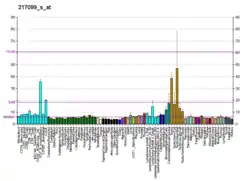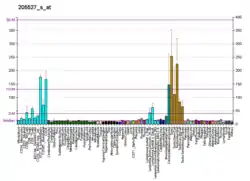Gem-associated protein 4
Gem-associated protein 4 is a protein that in humans is encoded by the GEMIN4 gene.[4][5]
| GEMIN4 | |||||||||||||||||||||||||
|---|---|---|---|---|---|---|---|---|---|---|---|---|---|---|---|---|---|---|---|---|---|---|---|---|---|
| Identifiers | |||||||||||||||||||||||||
| Aliases | GEMIN4, HC56, HCAP1, HHRF-1, p97, gem nuclear organelle associated protein 4, NEDMCR | ||||||||||||||||||||||||
| External IDs | OMIM: 606969 MGI: 2449313 HomoloGene: 69193 GeneCards: GEMIN4 | ||||||||||||||||||||||||
| |||||||||||||||||||||||||
| |||||||||||||||||||||||||
| |||||||||||||||||||||||||
| Orthologs | |||||||||||||||||||||||||
| Species | Human | Mouse | |||||||||||||||||||||||
| Entrez | |||||||||||||||||||||||||
| Ensembl | |||||||||||||||||||||||||
| UniProt | |||||||||||||||||||||||||
| RefSeq (mRNA) | |||||||||||||||||||||||||
| RefSeq (protein) | |||||||||||||||||||||||||
| Location (UCSC) | Chr 17: 0.74 – 0.75 Mb | n/a | |||||||||||||||||||||||
| PubMed search | [2] | [3] | |||||||||||||||||||||||
| Wikidata | |||||||||||||||||||||||||
| |||||||||||||||||||||||||
Function
The product of this gene is part of the SMN protein complex localized to the cytoplasm, nucleoli, and to discrete nuclear bodies called Gemini bodies (gems). The complex functions in spliceosomal snRNP assembly in the cytoplasm, and regenerates spliceosomes required for pre-mRNA splicing in the nucleus. The encoded protein directly interacts with a DEAD box protein and several spliceosome core proteins. Alternatively spliced transcript variants have been described, but their biological validity has not been determined.[5]
Interactions
GEMIN4 has been shown to interact with:
References
- GRCh38: Ensembl release 89: ENSG00000179409 - Ensembl, May 2017
- "Human PubMed Reference:". National Center for Biotechnology Information, U.S. National Library of Medicine.
- "Mouse PubMed Reference:". National Center for Biotechnology Information, U.S. National Library of Medicine.
- Charroux B, Pellizzoni L, Perkinson RA, Yong J, Shevchenko A, Mann M, Dreyfuss G (April 2000). "Gemin4: A Novel Component of the Smn Complex That Is Found in Both Gems and Nucleoli". J Cell Biol. 148 (6): 1177–86. doi:10.1083/jcb.148.6.1177. PMC 2174312. PMID 10725331.
- "Entrez Gene: GEMIN4 gem (nuclear organelle) associated protein 4".
- Carnegie GK, Sleeman JE, Morrice N, Hastie CJ, Peggie MW, Philp A, Lamond AI, Cohen PT (May 2003). "Protein phosphatase 4 interacts with the Survival of Motor Neurons complex and enhances the temporal localisation of snRNPs". J. Cell Sci. 116 (Pt 10): 1905–13. doi:10.1242/jcs.00409. PMID 12668731.
- Mourelatos Z, Dostie J, Paushkin S, Sharma A, Charroux B, Abel L, Rappsilber J, Mann M, Dreyfuss G (March 2002). "miRNPs: a novel class of ribonucleoproteins containing numerous microRNAs". Genes Dev. 16 (6): 720–8. doi:10.1101/gad.974702. PMC 155365. PMID 11914277.
- Nelson PT, Hatzigeorgiou AG, Mourelatos Z (March 2004). "miRNP:mRNA association in polyribosomes in a human neuronal cell line". RNA. 10 (3): 387–94. doi:10.1261/rna.5181104. PMC 1370934. PMID 14970384.
- Park JW, Voss PG, Grabski S, Wang JL, Patterson RJ (September 2001). "Association of galectin-1 and galectin-3 with Gemin4 in complexes containing the SMN protein". Nucleic Acids Res. 29 (17): 3595–602. doi:10.1093/nar/29.17.3595. PMC 55878. PMID 11522829.
- Meister G, Bühler D, Laggerbauer B, Zobawa M, Lottspeich F, Fischer U (August 2000). "Characterization of a nuclear 20S complex containing the survival of motor neurons (SMN) protein and a specific subset of spliceosomal Sm proteins". Hum. Mol. Genet. 9 (13): 1977–86. doi:10.1093/hmg/9.13.1977. PMID 10942426.
Further reading
- Meister G, Bühler D, Laggerbauer B, Zobawa M, Lottspeich F, Fischer U (2000). "Characterization of a nuclear 20S complex containing the survival of motor neurons (SMN) protein and a specific subset of spliceosomal Sm proteins". Hum. Mol. Genet. 9 (13): 1977–86. doi:10.1093/hmg/9.13.1977. PMID 10942426.
- Pellizzoni L, Charroux B, Rappsilber J, Mann M, Dreyfuss G (2001). "A Functional Interaction between the Survival Motor Neuron Complex and RNA Polymerase II". J. Cell Biol. 152 (1): 75–85. doi:10.1083/jcb.152.1.75. PMC 2193649. PMID 11149922.
- Wiemann S, Weil B, Wellenreuther R, Gassenhuber J, Glassl S, Ansorge W, Böcher M, Blöcker H, Bauersachs S, Blum H, Lauber J, Düsterhöft A, Beyer A, Köhrer K, Strack N, Mewes HW, Ottenwälder B, Obermaier B, Tampe J, Heubner D, Wambutt R, Korn B, Klein M, Poustka A (2001). "Toward a Catalog of Human Genes and Proteins: Sequencing and Analysis of 500 Novel Complete Protein Coding Human cDNAs". Genome Res. 11 (3): 422–35. doi:10.1101/gr.GR1547R. PMC 311072. PMID 11230166.
- Park JW, Voss PG, Grabski S, Wang JL, Patterson RJ (2001). "Association of galectin-1 and galectin-3 with Gemin4 in complexes containing the SMN protein". Nucleic Acids Res. 29 (17): 3595–602. doi:10.1093/nar/29.17.3595. PMC 55878. PMID 11522829.
- Qin WX, Wan F, Sun FY, Zhang PP, Han LW, Huang Y, Jiang HQ, Zhao XT, He M, Ye Y, Cong WM, Wu MC, Zhang LS, Yang NW, Gu JR (2002). "Cloning and characterization of a novel gene (C17orf25) from the deletion region on chromosome 17p13.3 in hepatocelular carcinoma". Cell Res. 11 (3): 209–16. doi:10.1038/sj.cr.7290088. PMID 11642406.
- Friesen WJ, Paushkin S, Wyce A, Massenet S, Pesiridis GS, Van Duyne G, Rappsilber J, Mann M, Dreyfuss G (2001). "The Methylosome, a 20S Complex Containing JBP1 and pICln, Produces Dimethylarginine-Modified Sm Proteins". Mol. Cell. Biol. 21 (24): 8289–300. doi:10.1128/MCB.21.24.8289-8300.2001. PMC 99994. PMID 11713266.
- Gubitz AK, Mourelatos Z, Abel L, Rappsilber J, Mann M, Dreyfuss G (2002). "Gemin5, a novel WD repeat protein component of the SMN complex that binds Sm proteins". J. Biol. Chem. 277 (7): 5631–6. doi:10.1074/jbc.M109448200. PMID 11714716.
- Pellizzoni L, Baccon J, Rappsilber J, Mann M, Dreyfuss G (2002). "Purification of native survival of motor neurons complexes and identification of Gemin6 as a novel component". J. Biol. Chem. 277 (9): 7540–5. doi:10.1074/jbc.M110141200. PMID 11748230.
- Baccon J, Pellizzoni L, Rappsilber J, Mann M, Dreyfuss G (2002). "Identification and characterization of Gemin7, a novel component of the survival of motor neuron complex". J. Biol. Chem. 277 (35): 31957–62. doi:10.1074/jbc.M203478200. PMID 12065586.
- Carnegie GK, Sleeman JE, Morrice N, Hastie CJ, Peggie MW, Philp A, Lamond AI, Cohen PT (2004). "Protein phosphatase 4 interacts with the Survival of Motor Neurons complex and enhances the temporal localisation of snRNPs". J. Cell Sci. 116 (Pt 10): 1905–13. doi:10.1242/jcs.00409. PMID 12668731.
- Di Y, Li J, Zhang Y, He X, Lu H, Xu D, Ling J, Huo K, Wan D, Li YY, Gu J (2004). "HCC-associated protein HCAP1, a variant of GEMIN4, interacts with zinc-finger proteins". J. Biochem. 133 (6): 713–8. doi:10.1093/jb/mvg091. PMID 12869526.
- Wan D, He M, Wang J, Qiu X, Zhou W, Luo Z, Chen J, Gu J (2004). "Two variants of the human hepatocellular carcinoma-associated HCAP1 gene and their effect on the growth of the human liver cancer cell line Hep3B". Genes Chromosomes Cancer. 39 (1): 48–58. doi:10.1002/gcc.10293. PMID 14603441. S2CID 20451424.
- Nelson PT, Hatzigeorgiou AG, Mourelatos Z (2004). "miRNP:mRNA association in polyribosomes in a human neuronal cell line". RNA. 10 (3): 387–94. doi:10.1261/rna.5181104. PMC 1370934. PMID 14970384.
- Shpargel KB, Matera AG (2006). "Gemin proteins are required for efficient assembly of Sm-class ribonucleoproteins". Proc. Natl. Acad. Sci. U.S.A. 102 (48): 17372–7. doi:10.1073/pnas.0508947102. PMC 1297697. PMID 16301532.
- Ewing RM, Chu P, Elisma F, Li H, Taylor P, Climie S, McBroom-Cerajewski L, Robinson MD, O'Connor L, Li M, Taylor R, Dharsee M, Ho Y, Heilbut A, Moore L, Zhang S, Ornatsky O, Bukhman YV, Ethier M, Sheng Y, Vasilescu J, Abu-Farha M, Lambert JP, Duewel HS, Stewart II, Kuehl B, Hogue K, Colwill K, Gladwish K, Muskat B, Kinach R, Adams SL, Moran MF, Morin GB, Topaloglou T, Figeys D (2007). "Large-scale mapping of human protein–protein interactions by mass spectrometry". Mol. Syst. Biol. 3 (1): 89. doi:10.1038/msb4100134. PMC 1847948. PMID 17353931.
This article is issued from Wikipedia. The text is licensed under Creative Commons - Attribution - Sharealike. Additional terms may apply for the media files.



